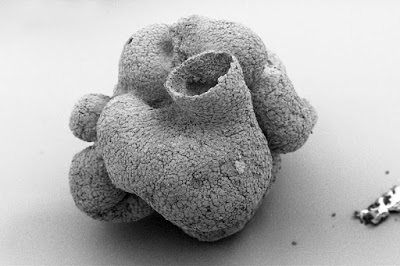
Researchers have unearthed a fossil of a sponge, no bigger than a grain of sand, that existed 60 million years earlier than many expected.
This is the first time paleontologists have found a convincing fossil sponge specimen that predates the Cambrian explosion—a 20-million-year phenomenon, beginning about 542 million years ago, when most major types of animal life appear.
New tools could allow scientists to discover other fossils that significantly predate the start of the Cambrian explosion, according to David Bottjer, professor of earth sciences, biological sciences and environmental studies and co-author of a study announcing the finding of the sponge in the Proceedings of the National Academy of Sciences.
“It’s easier to look at large fossils that don’t require high-tech instruments,” Bottjer said. “We’re analyzing very tiny things that require sophisticated microscopy, and we’re really just starting to look at this kind of evidence.”
Preserved fossils
Though some evidence, including molecular clocks, has already pointed to sponges evolving earlier, this fossil shows that the Cambrian explosion might not be a period when a large number of new traits emerged, but a period when a large number of fossils could be preserved, as animals during the Cambrian grew larger and gained skeletons.
“This specimen is of an animal that had already evolved a number of fundamental sponge traits,” Bottjer said. “It implies that by the time this animal was living, most of the developmental genes for sponges had evolved.”
This raises the possibility that some aspects of early animals’ evolution, a good deal of which happened during the Cambrian explosion, happened even more gradually.
With an international team of colleagues, Bottjer discovered that the millimeter-wide, 600-million-year-old fossil has characteristics that many thought emerged in sponges only 540 million years ago.
“Fundamental traits in sponges were not suddenly appearing in the Cambrian Period, which is when many think these traits were evolving, but many million years earlier,” Bottjer said. “To reveal these types of findings, you have to use pretty high-tech approaches and work with the best people around the world.”
Very old rocks
Since 1999, Bottjer has worked with a team of researchers from the Nanjing Institute of Geology and Palaeontology (Chinese Academy of Sciences) and the California Institute of Technology, as well as the European Synchrotron Radiation Facility in Grenoble, France.
Team members in China dissolved several 600 million-year-old rocks, which are regularly mined for Chinese agricultural fertilizer from the Doushantuo rock formation in southwestern China’s Guizhou Province. They then used a gentle acid bath to reveal tiny fossils made of calcium phosphate and a Scanning Electron Microscope (SEM) to determine which of those fossils were preserved well enough to merit analysis with the synchrotron.
“The preservation in these Doushantuo rocks is extremely fine—and you can even see individual cells with the SEM,” Bottjer said. “Once a specimen worthy of further study is found, synchrotron microscopy is used to create very, very detailed images of the fossil in two and three dimensions. From these images we are then able to see what types of animals these fossils represent.”
Future study lies in the relatively new field of paleogenomics, which analyzes the evolutionary history of genes to determine when individual genes first appeared. Bottjer said many of the genes operating in sponges 600 million years ago are the same genes that other animals have, including humans.
“These organisms don’t have all the bells and whistles that modern creatures do,” Bottjer said. “But this particular fossil has enough complexity that we can say we hadn’t been dating the early evolution of animal traits properly.”
Note: The above post is reprinted from materials provided by University of Southern California.










